Sputnik makes another stop on its visual cities’ tour across the globe. After Pyongyang, Shanghai and Tehran we invite you to Saint-Petersburg, Russia. St. Petersburg is one of the world’s most beautiful cities and has a grandiose historic and cultural legacy. Located on the Neva River at the head of the Gulf of Finland on the Baltic Sea, St. Petersburg is often called "the northern capital of Russia" and "the Venice of the North".

Saint Petersburg is the second largest city in Russia after Moscow. It is politically incorporated as a federal subject (a federal city). As for 2015, the population of the city is nearly 5.2 million people. The city occupies an area of 17.4 million square kilometers and is situated on 40 islands on the northern side of the Neva area.
Above: St. Petersburg residents walking on the Neva embankment.
Above: St. Petersburg residents walking on the Neva embankment.
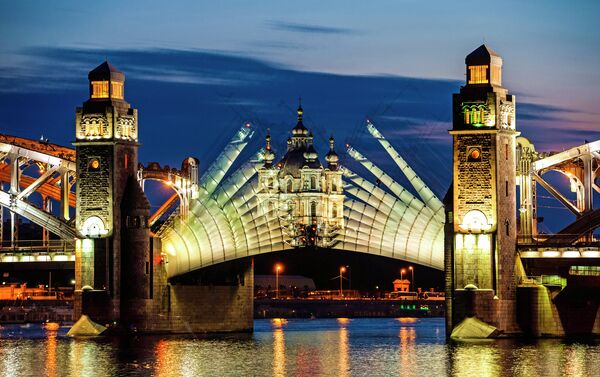
Saint Petersburg was founded by Tsar Peter the Great on May 27 1703 on marshy islands where the Neva River flows into the Gulf of Finland.
Above: A view of St. Peter the Great Bridge as it rises during white nights in St. Petersburg.
Above: A view of St. Peter the Great Bridge as it rises during white nights in St. Petersburg.

From its inception, the city was aimed to be a display of imperial Russia’s growing status in the world. Under Peter the Great’s successors, St. Petersburg grew to be the showcase capital of the Romanovs family and the first modern city in Russia.
Above: A view of the embankment of Vasilyevsky Island and the Stock Exchange from the bell tower of the Peter and Paul Fortress.
Above: A view of the embankment of Vasilyevsky Island and the Stock Exchange from the bell tower of the Peter and Paul Fortress.
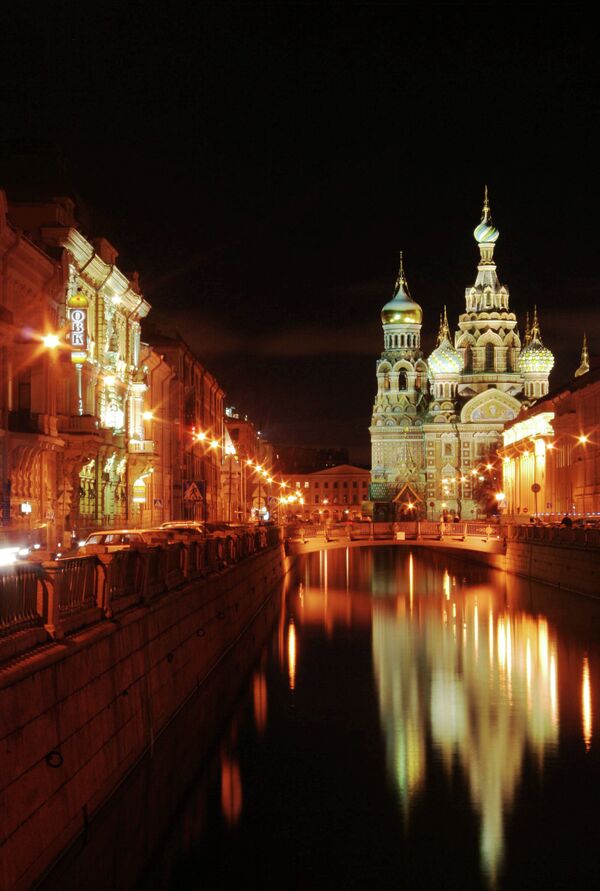
St. Petersburg is located in the Neva River lowlands, on a flat plain ranging from three to four meters above sea level. Although the geographical position cannot be considered perfect due to flooding risk, it has a favorable geopolitical location with access to the Northern Sea and the Atlantic Ocean.
Above: Church of the Savior on Blood with new illumination effects by Italian light designer Piero Castiglioni.
Above: Church of the Savior on Blood with new illumination effects by Italian light designer Piero Castiglioni.

Between 1713-1728 and 1732-1918 St. Petersburg was the imperial capital of Russia. In 1918, the central government bodies were moved from St. Petersburg to Moscow.
Above: A view of the Winter Palace from the bell tower of the Peter and Paul Fortress.
Above: A view of the Winter Palace from the bell tower of the Peter and Paul Fortress.
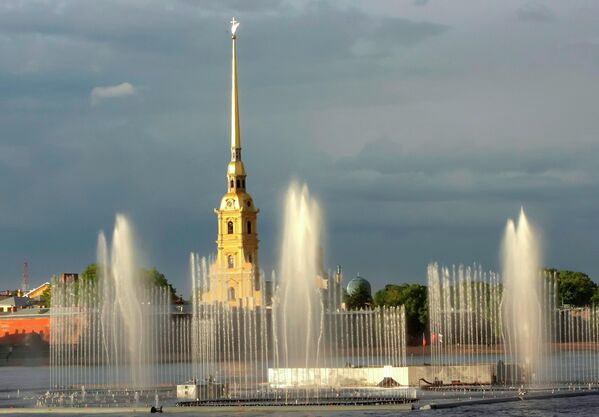
Throughout its history Saint Petersburg had three different names. Originally the city was named after St Peter, the patron of the city. In 1914 the city received the Russian version of the name – Petrograd. In 1924, after the leader of the October Revolution Vladimir Lenin died, the city was named after him – Leningrad. Finally, in 1991 the original name was restored.
Above: A musical water show, Dancing Fountains, on Vasilevsky Island's Spit in St. Petersburg.
Above: A musical water show, Dancing Fountains, on Vasilevsky Island's Spit in St. Petersburg.

The Peterhof Palace is a series of palaces and gardens located in Saint Petersburg. They were set up on the orders of Peter the Great as early as 1714. The Palaces and gardens are sometimes referred to as "Russian Versailles". Peter the Great saw Versailles when he traveled to France and was quite impressed. However the Russian emperor conceived his own fountain complex on a much grander scale.
Above: Fountains in the Peterhof open-air museum.
Above: Fountains in the Peterhof open-air museum.

During the Northern War between Russia and Sweden, in 1709 there was a decisive battle near Poltava in Ukraine which was our brilliant victory and the turning point of the whole war. Peter wanted to commemorate this victory for ages and ages and he dedicated the whole complex of Peterhof to the victory over Karl XII. A lot of talented architects were working in Peterhof (which means "Peter's court" in Dutch). They created a magnificent ensemble that includes several palaces and three parks. The main attraction in Peterhof is its beautiful Lower Park with 150 fountains and four cascades.
Above: A firework at the opening ceremony of the fountain season at the Peterhof open-air museum.
Above: A firework at the opening ceremony of the fountain season at the Peterhof open-air museum.
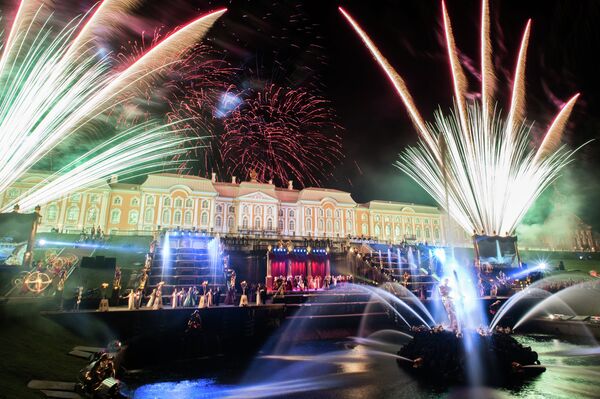
The greatest technological achievement of Peterhof is that all of the fountains operate without the use of pumps. Water is supplied from natural spring and collects in reservoirs in the Upper Gardens. The elevation difference creates the pressure that drives most of fountains of the Lower Garden.
Above: A light-and-music pageant at the Grand Cascade of the Peterhof palace and park ensemble in the environs of St. Petersburg on Fountain Day, which the city celebrates every autumn.
Above: A light-and-music pageant at the Grand Cascade of the Peterhof palace and park ensemble in the environs of St. Petersburg on Fountain Day, which the city celebrates every autumn.
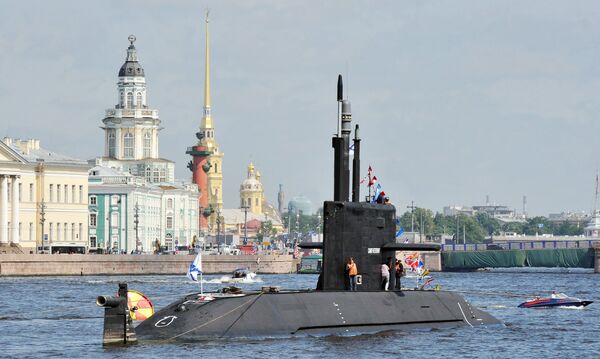
During the 20th century Saint Petersburg suffered three revolutions and a 900-day siege during the Great Patriotic War. The city received another descriptive name - "the city of three revolutions".
Above: A Russian submarine is anchored on the Neva River in front of the Peter and Paul Fortress during preparations for Navy Day celebrations in central Saint Petersburg.
Above: A Russian submarine is anchored on the Neva River in front of the Peter and Paul Fortress during preparations for Navy Day celebrations in central Saint Petersburg.

Saint Petersburg is one of the Russia’s most popular tourist attractions – both for domestic and foreign visitors.
Above: St. Petersburg's Kazan Cathedral.
Above: St. Petersburg's Kazan Cathedral.
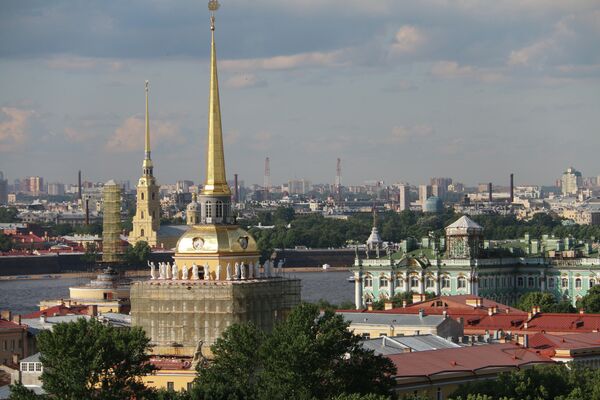
The city has over 200 museums, 100 theaters, 114 concert venues, 70 parks, 417 non-government cultural institutions, and 5,830 cultural landmarks.
Above: View from Saint Isaac's Cathedral
Above: View from Saint Isaac's Cathedral

13/21
Saint Petersburg has 93 rivers and canals with a total length of 300 kilometers. The main and widest river is the Neva River. There used to be 101 islands in the delta of Neva River, but now the number has decreased to 42.
Above: In this photo taken through a telescope lens, the city landmark, a weather vane in the form of an Angel, is fixed atop a spire of the Saints Peter and Paul Cathedral, as it is silhouetted on the rising moon in St. Petersburg.
Above: In this photo taken through a telescope lens, the city landmark, a weather vane in the form of an Angel, is fixed atop a spire of the Saints Peter and Paul Cathedral, as it is silhouetted on the rising moon in St. Petersburg.

Peter the Great was designing the city as another Amsterdam and Venice, with canals instead of streets. By his plans, in the summer months, the citizens were supposed to move around St. Petersburg in boats, and in the winter months when water freezes to move in sledges. At the time there were only 10 bridges in the city.
Above: Buildings on the Moika River embankment reflected in the water during the ice drift season in St. Petersburg.
Above: Buildings on the Moika River embankment reflected in the water during the ice drift season in St. Petersburg.

Nowadays, there are 342 bridges over rivers and canals of various sizes, stuyles and constructions, built at different periods.
Above: Fort Emperor Alexander I in Kronstadt.
Above: Fort Emperor Alexander I in Kronstadt.
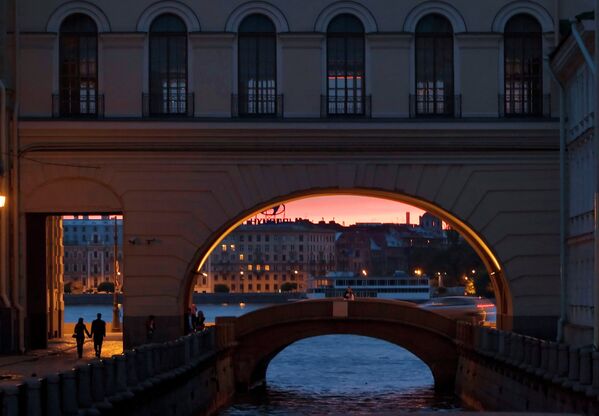
Saint Petersburg is especially famous for its moveable bridges.
Above: A view on the Winter Canal during the White Nights season in St. Petersburg.
Above: A view on the Winter Canal during the White Nights season in St. Petersburg.
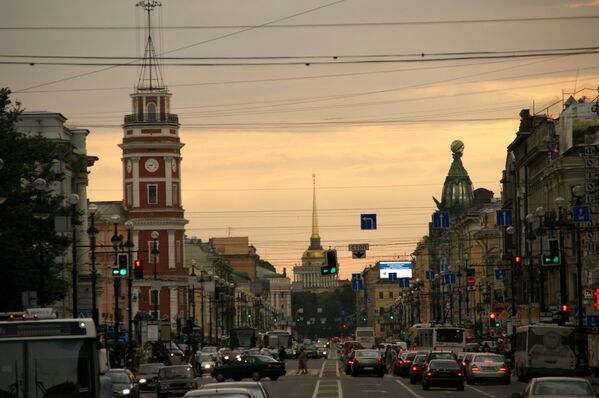
Saint Petersburg is a major trade gateway, financial and industrial center of Russia specializing in oil and gas trade, shipbuilding yards, aerospace industry, radio and electronics, software and computers; machine building, heavy machinery and transport, including tanks and other military equipment, mining, instrument manufacture etc.
Above: A view of the Nevsky Prospect in St. Petersburg.
Above: A view of the Nevsky Prospect in St. Petersburg.

Saint Petersburg is inscribed on the UNESCO World Heritage list as an area with 36 historical architectural complexes and around 4000 outstanding individual monuments of architecture, history and culture. New tourist programs and sightseeing tours have been developed for those wishing to see Saint Petersburg's cultural heritage.
Above: The Krasin icebreaker is tugged for repairs to the Kronshtadt Shipyard from the Lieutenant Shmidt Embankment, St. Petersburg.
Above: The Krasin icebreaker is tugged for repairs to the Kronshtadt Shipyard from the Lieutenant Shmidt Embankment, St. Petersburg.
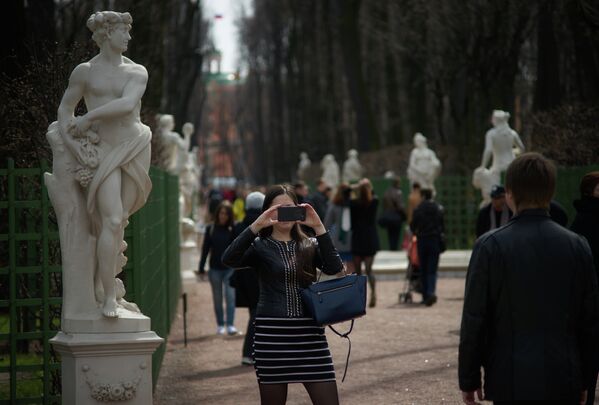
The city is also popular for its amazing White Nights when the sun does not descend below the horizon enough for the sky to grow dark.
Above: Visitors taking pictures at the Summer Garden, St. Petersburg.
Above: Visitors taking pictures at the Summer Garden, St. Petersburg.

Currently, thanks to its advantageous geopolitical position, a well-developed transportation system, a diversified economy and its cultural legacy, Saint Petersburg is one of the most developed and prosperous Russian cities.
Above: A view of the Blagoveshchensky (Annunciation) Bridge and St. Isaac's Cathedral at dawn in St. Petersburg.
Above: A view of the Blagoveshchensky (Annunciation) Bridge and St. Isaac's Cathedral at dawn in St. Petersburg.
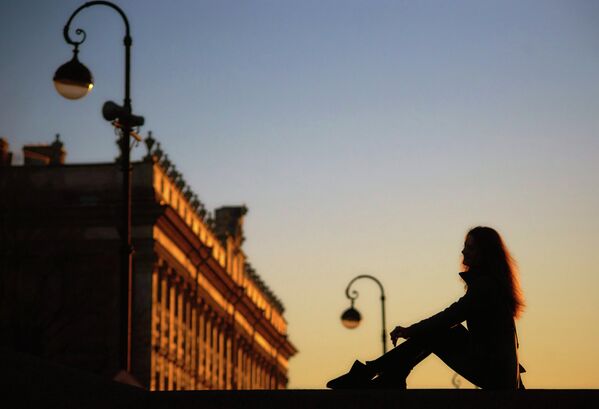
It is the second largest economic, academic and scientific center of the country. For many people, St. Petersburg is a unique place to live and work when the tradition meets high standards of modern life.
Above: Young woman on the Neva embankment.
Above: Young woman on the Neva embankment.



